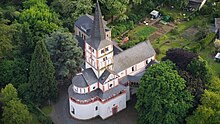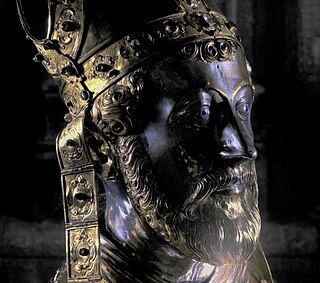
Saint Servatius was bishop of Tongeren. Servatius is patron saint of the city of Maastricht and the towns of Schijndel and Grimbergen. He is one of the Ice Saints. His feast day is May 13.
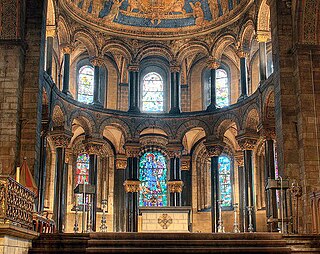
Mosan art is a regional style of art from the valley of the Meuse in present-day Belgium, the Netherlands, and Germany. Although in a broader sense the term applies to art from this region from all periods, it generally refers to Romanesque art, with Mosan Romanesque architecture, stone carving, metalwork, enamelling and manuscript illumination reaching a high level of development during the 11th, 12th and 13th centuries.

Maria Laach Abbey is a Benedictine abbey situated in Glees, on the southwestern shore of the Laacher See, in the Eifel region of the Rhineland-Palatinate in Germany. It is a member of the Beuronese Congregation within the Benedictine Confederation. The abbey was built in the 11th-12th centuries and was originally known as "Abtei Laach" until 1862 when the Jesuits added the name "Maria".

Saint Paul's Abbey in Lavanttal is a Benedictine monastery established in 1091 near the present-day market town of Sankt Paul im Lavanttal in the Austrian state of Carinthia. The premises centered on the Romanesque monastery church were largely rebuilt in a Baroque style in the 17th century.

St. Gereon's Basilica is a German Roman Catholic church in Cologne, dedicated to Saint Gereon, and designated a minor basilica on 25 June 1920. The first mention of a church at the site, dedicated to St. Gereon, appears in 612. However, the building of the current choir gallery, apse, and transepts occurred later, beginning under Archbishop Arnold II von Wied in 1151 and ending in 1227. It is one of twelve great churches in Cologne that were built in the Romanesque style.

Limburg Cathedral (German: Limburger Dom, also known as Georgsdom after its dedication to Saint George, is located above the old town of Limburg in Hesse, Germany. It is the cathedral of the Catholic Diocese of Limburg. Its high location on a rock above the river Lahn provides its visibility from far away. It is the result of an Early Gothic modernization of an originally Early Romanesque building and therefore shows a Romanesque-Gothic transitional style.

The Basilica of Saint Servatius is a Roman Catholic church dedicated to Saint Servatius, in the center of Maastricht, Netherlands. The architecturally hybrid but mainly Romanesque church is situated next to the Gothic Church of Saint John, backing onto the town's main square, Vrijthof.

San Frediano is a Romanesque-style Roman Catholic church in Pisa, Tuscany, Italy. It now functions as the official church of the University of Pisa.

Millstatt Abbey is a former monastery in Millstatt, Austria. Established by Benedictine monks about 1070, it ranks among the most important Romanesque buildings in the state of Carinthia. The Benedictines were succeeded by the knightly Order of Saint George in 1469 and the Society of Jesus in 1598.
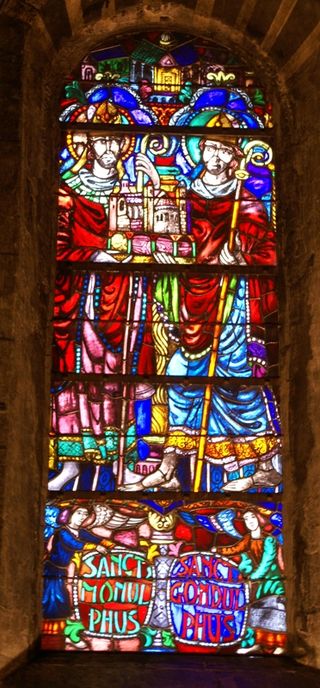
Monulph was a sixth-century bishop of Tongeren and Maastricht, and is revered as a Roman Catholic saint.
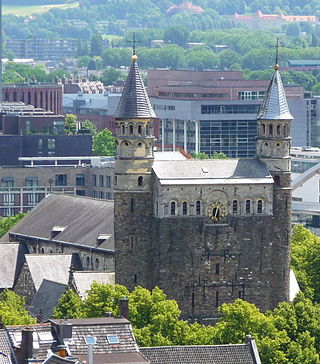
The Basilica of Our Lady is a Romanesque church in the historic center of Maastricht, Netherlands. The church is dedicated to Our Lady of the Assumption and is a Roman Catholic parish church in the Diocese of Roermond. The church is often referred to as the Star of the Sea, after the church's main devotion, Our Lady, Star of the Sea.

The Treasury of the Basilica of Saint Servatius is a museum of religious art and artifacts inside the Basilica of Saint Servatius in Maastricht, Netherlands.

A dwarf gallery is an architectural ornament in Romanesque architecture.

The Basilica of St. Castor is the oldest church in Koblenz in the German state of Rhineland Palatinate. It is located near Deutsches Eck at the confluence of the Rhine and the Moselle. A fountain called Kastorbrunnen was built in front of the basilica during Napoleon's invasion of Russia in 1812. Pope John Paul II raised St. Castor to a basilica minor on 30 July 1991. This church is worth seeing for the historical events that have occurred in it, its extensive Romanesque construction and its largely traditional furnishings.
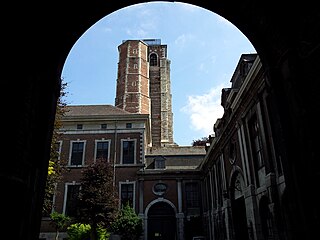
Sint-Truiden Abbey or St Trudo's Abbey is a former Benedictine monastery in Sint-Truiden in the province of Limburg, Belgium. The abbey was founded in the 7th century and was one of the oldest and most powerful in the Low Countries. The town of Sint-Truiden grew up around it. The great Romanesque abbey church, dedicated to Saint Remaclus and Saint Quintin, was demolished in 1798, four years after the suppression of the abbey.

The church St. Peter und Alexander is a Catholic church located in Aschaffenburg, Bavaria, Germany. It is the town's oldest church, established in the 10th century, dedicated to Saint Peter and Saint Alexander. The main building was built as a Roman basilica, while other phases were built in the early Gothic style. The current structure is a cruciform basilica, reflecting a variety of styles including a Romanesque nave from the 12th century and a 15th-century tower.
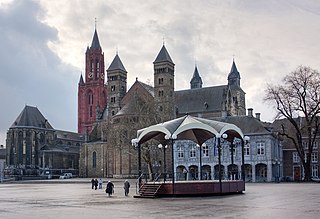
Vrijthof is a large urban square in the centre of Maastricht, Netherlands. The square developed from an ancient Roman and Frankish cemetery into a semi-private space that belonged to the Collegiate Church of Saint Servatius. In the 19th century, it became the town's main square. It is surrounded by important heritage buildings, museums, a theatre, and a range of hotels, restaurants, and bars. The square is regularly used for public events.

The Pilgrimage of the Relics or Maastricht Septennial Pilgrimage is a seven-yearly Catholic event in the Dutch city of Maastricht. Originating in the Middle Ages, it developed from a pilgrimage to the grave of Saint Servatius into the present-day religious, historical, cultural and commercial enterprise. Highlights in the programme are the displaying or unveiling of the relics in the main churches and secondly, the processions with the town's main relics. The next pilgrimage will take place in 2025.

Romanesque architecture appeared in France at the end of the 10th century, with the development of feudal society and the rise and spread of monastic orders, particularly the Benedictines, which built many important abbeys and monasteries in the style. It continued to dominate religious architecture until the appearance of French Gothic architecture in the Île-de-France between about 1140 and 1150.
